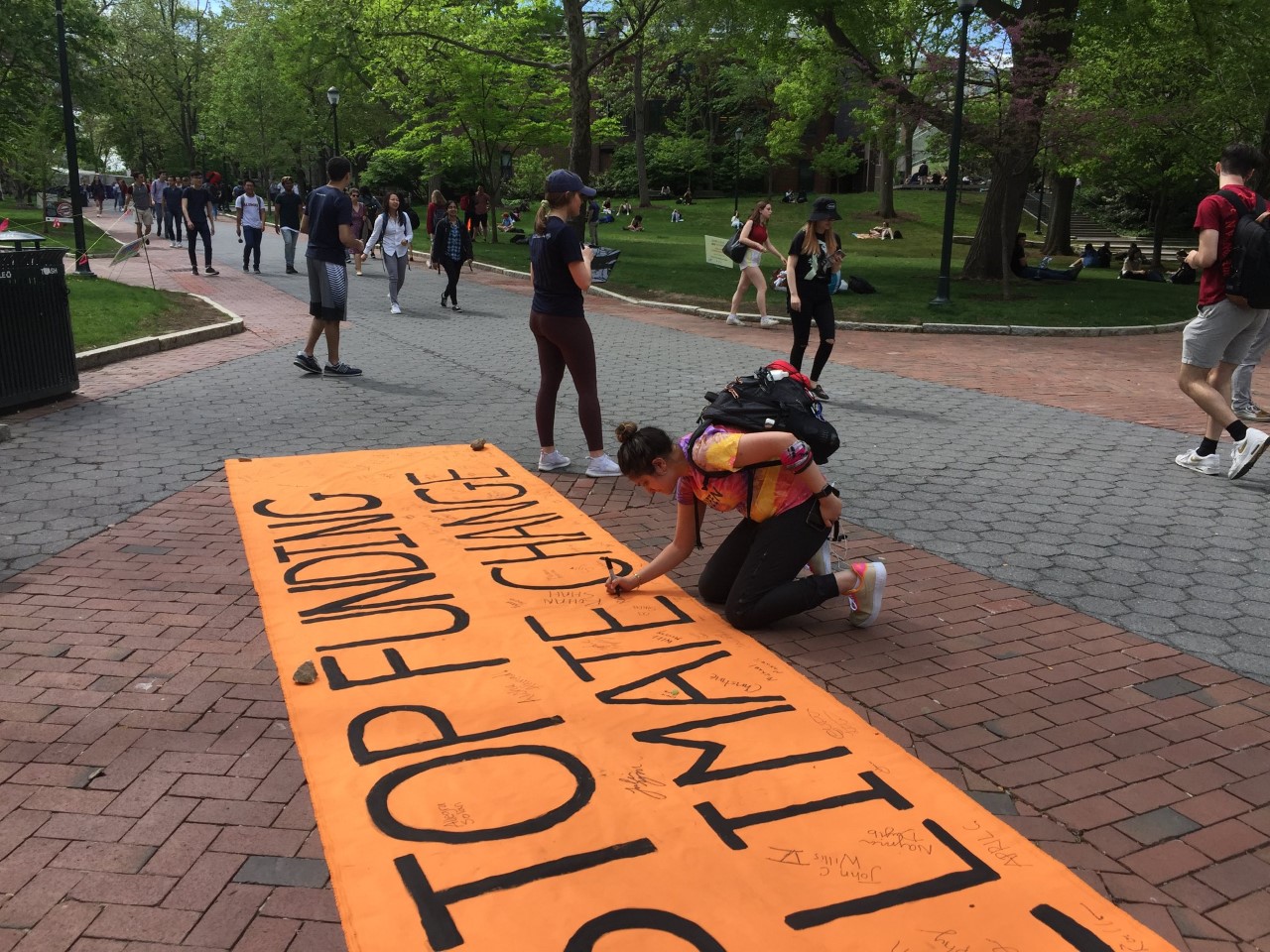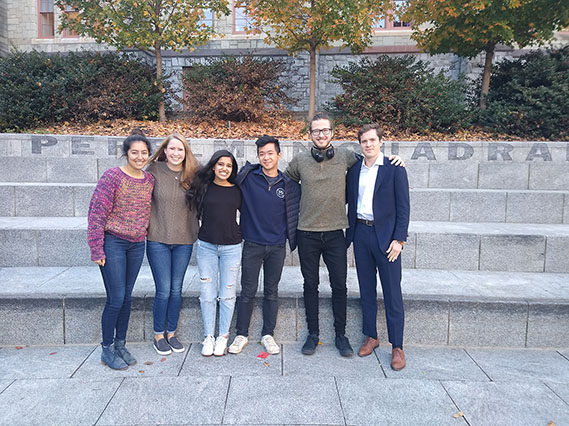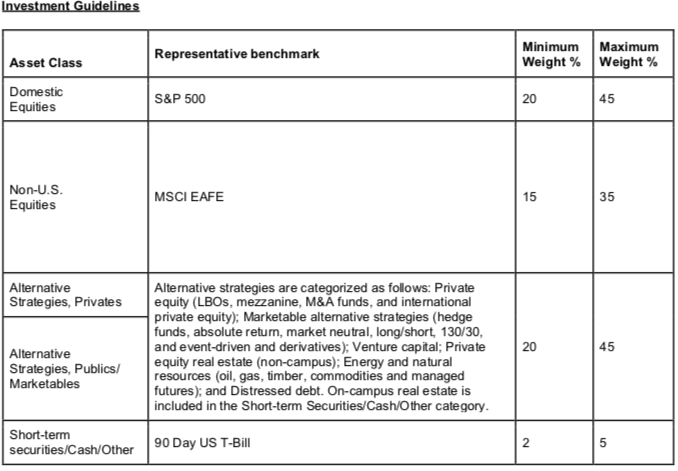Partnership to Encourage and Document Climate Finance on University Campuses
January 16, 2020
Bethany Wiggin
PPEH collaborates with Wharton Social Impact Initiative on Challenge to Invest University Endowments for Climate Solutions
Over the summer of 2019, PPEH initiated a collaboration with Wharton’s Social Impact Initiative (WSII) to challenge teams at colleges and universities across the country to invest a college endowment to drive climate solutions while generating a healthy return on investment. When thinking about many fund managers' resistance to taking meaningful action to stem the climate crisis, we at PPEH wanted to know: can you make money while acting on climate? It's a question a lot of smart climate activists have been asking. Maybe you saw writer Bill McKibben's essay in The New Yorker that circulated widely in fall 2019, "Money Is the Oxygen on Which the Fire of Global Warming Burns."

(Image Credit: Lucy Corlett)
As we considered the questions, we thought: who better to ask these ur-capitalist questions than our neighbors across campus at the Wharton School? And so we began talking with faculty and staff there, and we learned that in 2018 their Social Impact Initiative had established a program called the Total Impact Portfolio Challenge. It's a national competition that, in WSII's words, equips "students with the knowledge, skills, and experience to design and execute investment portfolios that maximize [positive social] impact across asset classes." The project received significant media attention, and you can read about how, in CNBC's words, "MBA Students Face Off."
PPEH and WSII faculty and staff met together over the summer and into the fall. I, PPEH's Faculty Director, asked if they would consider organizing this year's impact challenge around climate impact and university endowments--and was genuinely delighted when they readily agreed. We then worked together to craft an investor profile for fictional Pawnee College. You can read an executive summary of the college's investor profile at the bottom of this field note. But in a nutshell, Pawnee is a highly regarded liberal arts schools founded in 1892 and located on a beautiful campus. College leadership wishes to invest their endowment (of $250 million) to drive climate solutions, avoid climate risk, and slow climate change. (To put that in perspective, the endowment of the University of Pennsylvania totaled $14.7 billion as of June 2019.) Pawnee is further concerned about income inequality in a post-industrial landscape.
The Total Impact Portfolio Challenge featuring Pawnee launched successfully in late October. 47 teams on campuses across the country registered and some 215 students across the country are now exploring whether they can invest Pawnee's endowment to drive climate solutions while making a nice ROI. Their portfolios are due on March 1, and finalists will be announced in late March and travel to Philadelphia for the Challenge Finals in April.
At the same time the Challenge launched, PPEH created a new internship opportunity for Penn undergraduates who wanted to learn more about climate finance and to document what role university and college endowments might play. We selected a group of six terrific students in early November and you can learn a little about Greg, Anna, Alex, Vysh, Maria, and Brandon in this Field Note about this year's twelve Public Research Interns.

(Image Credit: Rachel Ishikawa)
Since November, the PPEH Finance interns and I have met weekly to build our own climate finance literacy. We began by noting the nearly feral proliferation of the term climate finance beyond its origins in UN climate negotiations. As intern Brandon Nguyen writes, "The increased prevalence of climate-related investments is driven by both demand for capital (given the unprecedented level of need for climate adaptation and mitigation projects) as well as supply of capital, as institutional investors seek a stable alternative asset class to diversify traditional investment portfolios." Together, the interns amassed an annotated bibliography about climate finance and identified a set of keywords for climate finance and wrote definitions for the interested public. Now, in January 2020, as the new semester gets underway, we expect the team's website to launch soon. It will provide a forum where interns will share their research findings and post profiles of the student endowment investors as well as interviews with experts on climate finance as well as with professional investors, on college campuses and off, who speak to the fundamental question with which this new collaboration between PPEH and WSII began: Can you invest to keep your endowment strong and simultaneously stem the flows of capital that feed the fires of climate change?
Please watch our for that site's launch--and, if you'd like to be interviewed, or would like to nominate someone, please be in touch at director@ppehlab.org
Investor Profile: Pawnee College
Executive Summary
Type of Assets: Endowment
Current Assets: $250,000,000 USD
Time Horizon: Perpetuity
Return Objective: The endowment satisfies need and expectations when returning 8% Spending Policy: 4% of a trailing moving average market value (Smoothed spending)
Background. Pawnee College, established in 1892, is devoted to excellence in teaching, research, and educating for the common good. With a beautiful suburban campus in Pawnee, Pennsylvania, Pawnee has an annual enrollment of 1500 undergraduates and 300 graduate students.
Pawnee was originally established as a school for liberal arts, and maintains a position as one of the best regarded undergraduate liberal arts schools. In addition to their excellence in liberal arts, their programs - both graduate and undergraduate - in actuarial science and data analytics have been growing. In total, Pawnee offers 21 total undergraduate degrees and 14 masters degrees.
The Pawnee Endowment, the College’s largest financial asset, is a perpetual source of support for the College and its mission of teaching and research. Pawnee has a successful history of fundraising campaigns for capital expenditures. The endowment’s primary mission is to support faculty and students, including professorships and financial aid for undergraduates, and student life and activities. The endowment satisfies need and expectations when returning 8%.
Endowments permanent capital, and are therefore prudently governed by long-term investment and spending policies that have been designed to balance the goal of endowment growth that keeps pace with inflation and spending that supports generations of stakeholders fairly and in perpetuity.
Investment Structure. The Pawnee Endowment is a critical, strategic asset for the College’s growth and mission. Pawnee’s Endowment’s investment structure includes various asset classes, investment management styles, asset allocation, and acceptable ranges that, in total, are designed to produce a sufficient level of overall diversification and total investment return potential over the long-term.
Statement of Portfolio Objectives. The perpetual nature of the Endowment is both a challenge and a competitive advantage. The Endowment’s perpetual time horizon and relatively low spending requirements allows the Endowment to weather higher volatility and illiquidity.
In both public and private markets, the Endowment views investments as the ownership of stakes in underlying businesses. Investments are evaluated based upon the fundamental value created by the businesses over time, and not merely by short-term performance.
As stewards of the Endowment, the investment team’s foremost responsibility is the preservation and growth of capital that allows the College to train their students to be multi-disciplinary leaders around the world.
The Endowment provides critical support for current programs and the promise of consistent resources into the future. Even in challenging financial times the endowment fortifies the College’s ability to support student financial aid, teaching, research, innovation, and other student activities.
The Endowment recognizes climate risk to pose a material risk to its investment portfolio and would want to invest in securities - across traditional and alternative strategies - that either screens for such risks or actively contributes to solutions or the development of solutions that address and mitigate climate change risk, and stranded assets risk. Climate risk management is an evolving practice and the Endowment wants to partner with managers and advisors who are proactively developing and analyzing best practices.
The Endowment’s climate risk stance is in accordance with the College’s broader vision of reducing emissions and adopting sustainable practices across the board. The College Board of Trustees are currently evaluating several plans to transition to energy-efficient infrastructure and facilities on campus to improve sustainability goals and reduce long term capital needs.
The Endowment also acknowledges that in a competitive environment, the ability to identify high growth potential, under-valued opportunities is enabled by working with a diverse and broad range of investment management firms. In that pursuit, the Endowment seeks to partner with a diverse and emerging set of managers to expand its set of opportunities to contribute to a higher endowment earnings.
Pawnee has for over 125 years engaged with the local community of Locum. The Locum economy was thriving as a manufacturing town 125 years ago, but now lacks significant economic opportunity. Locum is not an isolated example. The Endowment recognizes that growing income inequality is a threat not only to the social unity of the country but also sustained financial stability. The Endowment is interested in learning how managers are factoring this risk into their investment analysis methodologies.
The endowment team has full discretion over asset allocation and portfolio construction.

Impact Reporting & Metric Systems. The field of ESG and impact investing is rapidly evolving. Accordingly, the Committee is open to adopting any system of ESG and impact reporting and metrics so long as the system has been developed by a reputable and authoritative organization. The Committee is also open to in-house frameworks to supplement the external reporting systems.
